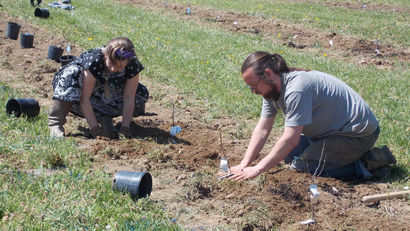nafex@lists.ibiblio.org
Subject: North American Fruit Explorers mailing list at ibiblio
List archive
[nafex] Global pawpaw expert bring his fruits to Kearneysville [The (Martinsburg, W. Va.) Journal]
- From: "Brungardt, Sam (MPCA)" <sam.brungardt@state.mn.us>
- To: nafex mailing list at ibiblio <nafex@lists.ibiblio.org>
- Subject: [nafex] Global pawpaw expert bring his fruits to Kearneysville [The (Martinsburg, W. Va.) Journal]
- Date: Mon, 29 Apr 2013 16:31:17 +0000
http://www.journal-news.net/page/content.detail/id/593841/Global-pawpaw-expert-brings-his-fruits-to-Kearneysville.html?nav=5006
Global pawpaw expert brings his fruits to Kearneysville
April 27, 2013
By Michelle Horst (mhorst@journal-news.net<mailto:mhorst@journal-news.net>) ,
journal-news.net
Save<http://www.journal-news.net/?page=mscontent.saveContentMsg&showlayout=0&id=593841&nav=5006>
| Comments
(10)<http://www.journal-news.net/page/content.comment/id/593841/Global-pawpaw-expert-brings-his-fruits-to-Kearneysville.html?nav=5006>
| Post a
comment<http://www.journal-news.net/page/content.comment/id/593841/Global-pawpaw-expert-brings-his-fruits-to-Kearneysville.html?nav=5006>
|
KEARNEYSVILLE - Neal Peterson stood overlooking the volunteers planting some
50 dozen small pawpaw trees. Some still in pots, all grouped by families, the
tiny trees were the creation of his own hands and many years of research.
Peterson, a global expert on the pawpaw fruit, began his research in the
1980s by looking through antique collections dating back to the early 1920s.
The best material of his results was shared with 11 different universities,
and the work continues today.
"I was evaluating quality, flavor, color - anything that could someday be in
a grocery store," Peterson said.
Article Photos
[http://www.journal-news.net/photos/news/md/593841_1.jpg]
Journal photo by Michelle Horst
Volunteers spent Thursday planting 600 pawpaw trees at the Kearneysville Tree
Fruit Research and
Education Center.
The pawpaw native to the Eastern Panhandle grows on trees ranging from 20 to
30 feet in height. The variety varies in different areas - pawpaws in Florida
grow on small shrubs only 3 feet tall.
By hand-pollinating a mixture of different mother and father plants, Peterson
used hybridization to create his own trees, growing between 8 and 10 feet
tall, and named the varieties for local places such as the Potomac,
Shenandoah and Susquehanna.
Pawpaws native to the Eastern Panhandle can be found growing along the
Potomac River and the C&O Canal. The leaves are simple and oblong with smooth
edges. The fruit varies in size, depending on the number of seeds inside - it
can be anywhere from a hen's egg to the size of a large mango. The taste is
similar to a banana or mango.
Some believe this fruit could revolutionize the orchard industry in the
Eastern Panhandle, which has been dwindling since the apple industry began
shrinking in the 1990s.
According to Dr. Alan Biggs of West Virginia University's Kearneysville Tree
Fruit Research and Education Center, the dropoff in the apple industry was
caused by low processed apple prices and fruit juice coming from China.
"West Virginia is ranked anywhere from 6 to 12 in the nation for apple
production, and this station has been a big part of that," Biggs said.
Through communication with Peterson over several years, Biggs was able to
bring the Peterson Pawpaw Project to the research center as an experimental
orchard.
Volunteers spent Thursday in the dirt, planting six long rows, each of 100
small pawpaw trees, over more than one-quarter of an acre.
Andy Moore, of Pittsburgh, Pa., was one of the volunteers helping to plant
the trees. He is in the midst of writing a book on the history of the pawpaw
fruit, and has conducted several interviews with Peterson for his research.
"It's a mystery to me why folks don't know about (the pawpaw)," Moore said.
"It can be found in the woods anywhere in this part of the country. It's this
unknown thing, although it surrounds us."
"Also, it tastes really good," he said.
The small orchard in Kearneysville serves as an experiment for future uses.
Peterson said, for example, Ocean Spray had expressed interest, after tasting
some of his samples, in doing laboratory experiments with the pawpaw and
other juice blends - the company requested a ton of pawpaws to do experiments.
"Well, you have to already have some orchards going for that," Peterson said,
adding that dealings with Ocean Spray will be down the road.
The trees planted Thursday were between one and two years old, but like
everything, Peterson said, the pawpaws have to start somewhere.
"There was a time in the Eastern Panhandle when the first apple orchard went
in, shortly after the Civil War, then it became a thriving apple industry.
This is experimental, because, unlike the apple, pawpaw is very little
known," Peterson said.
- Staff writer Michelle Horst can be reached at 304-263-8931, ext. 138, or
www.twitter.com/mhorstJN<http://www.twitter.com/mhorstJN>.
(c) Copyright 2013 journal-news.net. All rights reserved. This material may
not be published, broadcast, rewritten or
redistributed.<http://www.journal-news.net/page/content.detail/id/593841/Global-pawpaw-expert-brings-his-fruits-to-Kearneysville.html?nav=5006#license-593841>
-
[nafex] Global pawpaw expert bring his fruits to Kearneysville [The (Martinsburg, W. Va.) Journal],
Brungardt, Sam (MPCA), 04/29/2013
- Re: [nafex] Global pawpaw expert bring his fruits to Kearneysville [The (Martinsburg, W. Va.) Journal], Charles Rhora, 04/29/2013
Archive powered by MHonArc 2.6.24.

